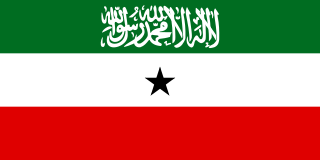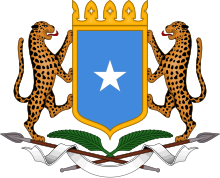
The coat of arms of the Republic of Croatia consists of one main shield and five smaller shields which form a crown over the main shield. The main coat of arms is a checkerboard (chequy) that consists of 13 red and 12 white fields. It is also informally known in Croatian as šahovnica. The five smaller shields represent five different historical regions within Croatia.

The national flag of Armenia, also known as the tricolour, consists of three horizontal bands of equal width, red on the top, blue in the middle, and orange on the bottom. The Armenian Supreme Soviet adopted the current flag on 24 August 1990. On 15 June 2006, the Law on the National Flag of Armenia, governing its usage, was passed by the National Assembly of Armenia.

The flag of Bolivia is the national flag of the Plurinational State of Bolivia. It was originally adopted in 1851. The state and war flag is a horizontal tricolor of red, yellow and green with the Bolivian coat of arms in the center. According to one source, the red stands for Bolivia's brave soldiers, while the green symbolizes fertility and yellow the nation's mineral deposits.

The flag of Somalia, also known as the Somali flag, was adopted on October 12, 1954, and was designed by Mohammed Awale Liban. The flag was initially used within the Trust Territory of Somaliland before being adopted by the short-lived State of Somaliland and the Somali Republic. It is an ethnic flag for the Somali people; the flag's five-pointed star represents the five regions in which Somalis reside.

A red star, five-pointed and filled, is a symbol that has often historically been associated with communist ideology, particularly in combination with the hammer and sickle, but is also used as a purely socialist symbol in the 21st century. It has been widely used in flags, state emblems, monuments, ornaments, and logos.

The coat of arms of Montenegro was officially adopted by the law passed in the Parliament on 12 July 2004. It is now the central motif of the flag of Montenegro, as well as the coat of arms of the Armed Forces of Montenegro. It was constitutionally sanctioned by the Constitution proclaimed on 2 October 2007.

The coat of arms of Somalia was adopted on October 10, 1956 and features a golden framed shield of the Somali flag supported by two Leopards standing on spears. The Leopard is a common animal seen in Somalia. Leopards are a common motif in Somali culture.
Pakistan has several official national symbols, including a flag, an emblem, an anthem, a memorial tower as well as several national heroes. The symbols were adopted at various stages in the existence of Pakistan and there are various rules and regulations governing their definition or use. The oldest symbol is the Lahore Resolution, adopted by the All India Muslim League on 23 March 1940, and which presented the official demand for the creation of a separate country for the Muslims of India. The Minar-e-Pakistan memorial tower which was built in 1968 on the site where the Lahore Resolution was passed. The national flag was adopted just before independence was achieved on 14 August 1947. The national anthem and the state emblem were each adopted in 1954. There are also several other symbols including the national animal, bird, flower and tree.

The national emblem of Somaliland, was introduced on 14 October 1996 along with the flag of Somaliland, when it was approved by the National Conference. It was introduced by Abdullahi Abdi Omar (Jawaan).
The national symbols of Lithuania are used in Lithuania and abroad to represent the country and its people, history, culture, and nature. These symbols are seen in official capacities, such as flags, coats of arms, postage stamps, and currency, and in URLs. They appear less formally as recurring themes in literature, art and folk art, heraldry, monuments, clothing, personal decoration, and as the names of parks, bridges, streets, and clubs. The less formal manifestations may be classified as national emblems.

The current flag of Andalusia was adopted in 1918. Blas Infante (1885–1936), the "Father of the Andalusian Fatherland", initiated an assembly at Ronda in 1918. This assembly adopted a charter based on the Antequera Constitution and also adopted the current flag of Andalusia and emblem as "national symbols". Its name used to be Arbonaida or also Arbondaira.
Upon the independence of Belarus from the Soviet Union, the country resurrected national symbols that were used before the Soviet era. These included a flag of red and white stripes and a coat of arms consisting of a charging knight on horseback. These national symbols were replaced by Soviet-era symbols in a disputed 1995 vote. Those two symbols, along with the national anthem, are the constitutionally defined national symbols of Belarus.

The following outline is provided as an overview and topical guide to Somaliland:

The coat of arms of Singapore is the heraldic symbol representing the sovereign island country and city-state of Singapore located in maritime Southeast Asia. It was adopted in 1959, the year Singapore attained self-governance from the British Empire, and remains in use after its independence in 1965. The committee that created it, headed by Toh Chin Chye, who was also responsible for the national flag and the national anthem of Singapore.
National symbols of Singapore are the symbols that are used in Singapore to represent what is unique about the nation, reflecting different aspects of its cultural life and history.

Since unification in 1910, South Africa has used a range of national symbols to identify the country: coats of arms, official seals, flags, national anthems, and floral, bird, animal, and other emblems.

National symbols of Indonesia are symbols that represent Republic of Indonesia. It can represent Indonesia as a nation, Indonesian people, culture, arts, and its biodiversity. The official symbols of Indonesia are officially recognise symbols that represent Indonesia and enforced through Indonesian laws. These symbols of the state that represent Indonesian nationhood are Garuda Pancasila, Merah-Putih flag, Indonesia Raya national anthem, and Indonesian language.

On 2 June 1992, the Nagorno-Karabakh Republic (NKR), a former breakaway state in the South Caucasus region, adopted a flag derived from the flag of Armenia, to which a white, five-toothed, stepped carpet pattern is added, beginning at the two verges of the flag's fly and meeting at a point equal to one-third of the distance from that side. The NKR was renamed the Republic of Artsakh in 2017 after a referendum and retained the flag. Following an Azerbaijani offensive on 19 September 2023, Artsakh agreed to dissolve itself by 1 January 2024.

The national symbols of the Czech Republic are flags, heraldry, cultural expressions and other symbols that represent the Czech Republic, Czech people and their history, culture and nationhood. There are six official symbols which are declared in the Constitution of the Czech Republic. However many other historical, cultural and geographical symbols of the Czech republic and Czech people do exist.
National symbols of Switzerland are the symbols used to represent Switzerland. As of 2020 the Swiss legislature has made three Swiss national symbols official, a flag, coat of arms, and anthem, but various other symbols are used as well to represent the Swiss people.
















